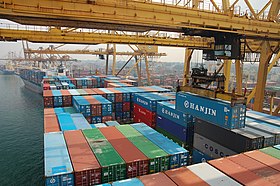Colombo Harbour
| Port of Colombo | |
|---|---|
 |
|
| Location | |
| Country | Sri Lanka |
| Location | Colombo |
| Coordinates | 06°57′10″N 79°50′41″E / 6.95278°N 79.84472°ECoordinates: 06°57′10″N 79°50′41″E / 6.95278°N 79.84472°E |
| Details | |
| Opened | Ancient |
| Operated by | Sri Lanka Ports Authority |
| Type of harbor | Seaport |
| Land area | 4.8 km2 (1,200 acres) |
| Size | Large |
| Available berths | 51 |
| Piers | 27 |
| Vision | LOGISTIC EXCELLENCE IN THE SILK ROUTE |
| Statistics | |
| Annual cargo tonnage | 30.9 million (2008) |
| Annual container volume | 5.7 millionTEUs |
|
Website http://www.slpa.lk/ |
|
The Port of Colombo (known as Port of Kolomtota during the early 14th Century Kotte Kingdom) is the largest and busiest port in Sri Lanka. Located in Colombo, on the southwestern shores on the Kelani River, it serves as an important terminal in Asia due to its strategic location in the Indian Ocean. During the 1980s, the port underwent rapid modernization with the installation of Cranes, Gantries and other modern-day terminal requirements. Currently with a capacity of 5.7 million TEUs and a dredged depth of over 15 m (49 ft), the Colombo Harbour is one of the busiest ports in the world, and ranks among the top 35 ports. It is also one of the biggest artificial harbours in the world handling most of the country's foreign trade. It has an annual cargo tonnage of 30.9 million tons. The port is also the naval base for Sri Lanka Navy Western Fleet under the Commander Western Naval Area (COMWEST). The Port of Colombo is home to the second tallest building in South Asia and is the center for many commercial interests.
The Port of Colombo was known to Roman, Arab, and Chinese traders more than 2000 years ago. By the 8th century, Arab Muslim traders settled in Colombo as a base for their trade for that part of the world. Today, they make up the local Sri Lankan Moor community.
Among the users of the port, China, India and Persia were among the first people to use the harbour. In 1505 the Portuguese first discovered the Port of Colombo when first arriving to the island. In an effort to protect the coast from invaders the King of Kotte at the time, Parakamabahu VIII made a treaty with the Portuguese giving them the right to trade cinnamon from the island, and receiving full authority of the coastline. The Portuguese established a trading post in the port but they soon expelled the Muslims and began building a fort in 1517.
...
Wikipedia
